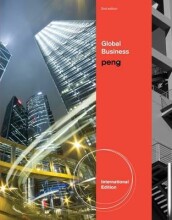Summary: Global Business | 9780538475532 | Mike W Peng
- This + 400k other summaries
- A unique study and practice tool
- Never study anything twice again
- Get the grades you hope for
- 100% sure, 100% understanding
Read the summary and the most important questions on Global business | 9780538475532 | Mike W. Peng.
-
6 Investing Abroad Directly
-
6.5 Internalization Advantages
-
How does FDI lead to internalization advantages?
FDI reduces international transaction costs, which arise because firms want to reduce uncertainties with laws and regulations. Interfirm trade will occur when te MNE spans both countries. -
6.6 Realities of FDI
-
Name and explain the three different political views on FDI
- Radical view
- Is hostile to FDI. Roots of Marxism. Seen as exploiting domestic resources and people. Governments nationalize MNE's or ban FDI instream. Declining view because economic development is poor.
- FDI unrestriced by government intervention will enable countries to exploit their absolute or comparitive advantages.
3. Pragmatic Nationalism- Most practiced view. Considering FDI only when the benefits outweigh the costs
-
What is the "demonstration effect"?
The effect which occurs in a country when a MNE takes technology from its home country and uses it in a host country. Technological spillover will occur and host country firms will strive to imitate. -
6.7 How MNEs and Host Governments bargain
-
Explain how MNEs and host governments bargain
Negotiations are ruled by each side's relative bargaining power and are steered by the three C's: Common interest, Conflicting interest and compromises.Obsolescing bargainsRound 1: A deal is negotiated. MNE receives incentives(f.e. Tax Holidays)Round 2: MNE enters and earns profitsRound 3: Government is pressured by domestic groups to demand renegotiations because the MNE would be gaining excessive profits. MNE has to give in to demands because it already has sunk costs and may face either an exit a huge loss or even expropriation. -
Explain what a Sovereign Wealth Fund is
A state owned investment fund mostly found in oil-rich countries or other countries with high trade surpluses. Its mostly composed of financial assets such as stocks, bonds or real estate. -
9 Entering Foreign Markets
-
9.1 Overcoming the liability of foreignness
-
How do institutions and resources affect liability of foreignness?
Firstly there are differences in formal and informal institutions between countries. Foreigners need to learn the rules.Secondly foreign firms are still discriminated against, formally and informally.Institution based view states that firms must undertake legitimate and appropriate actions in accordance with the formal and informal institutions that govern the market.Resource-based view states that firms must deploy overwhelming resources -
9.2 Where to Enter?
This is a preview. There are 1 more flashcards available for chapter 9.2
Show more cards here -
Define cultural/insitutional distances and foreign entry locations
Cultural distance: The difference between two culturs along dimensions such as individualism vs. collectivismInstitutional distance: The extent of similarity or dissimilarity between the regulatory, normative, and cognitive insitutions of two countries. -
Define strategic goals and location specific advantages
Location-specific advantages:- Miami(gateway to North and Latin-america)
- Agglomeration(Silicon Valley). Agglomeration occurs when theres 1) Technological Spillover 2) Employees working for different firms without moving 3) Industry demand that allows a pool of specialized suppliers and buyers in one region. Strategic goals must go hand in hand with location-specific advantages.
-
9.3 When to Enter?
-
Compare first and late mover advantages
First mover: Gain a large market share.- Due to proprietary technology.
- They can also erect high entry barriers(high switching costs).
- Create precious relationships with important actors (costumers and governments)
- Avoid clashes with dominant firms at home
- Preemption of scarce resources
Late mover:- Free ride on first-mover investments
- Late movers face less technological and market uncertainties
- They can abuse the first-movers inflexibility
-
9.4 How to Enter?
This is a preview. There are 2 more flashcards available for chapter 9.4
Show more cards here -
Define a Build-Operate-Transfer Agreement
BOT is a non-equity mode of entry used to create a long-term presence.
- Higher grades + faster learning
- Never study anything twice
- 100% sure, 100% understanding






























